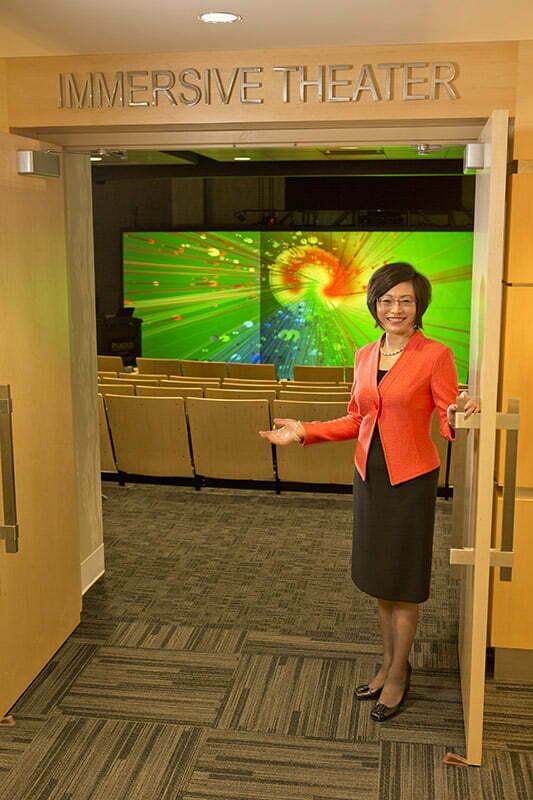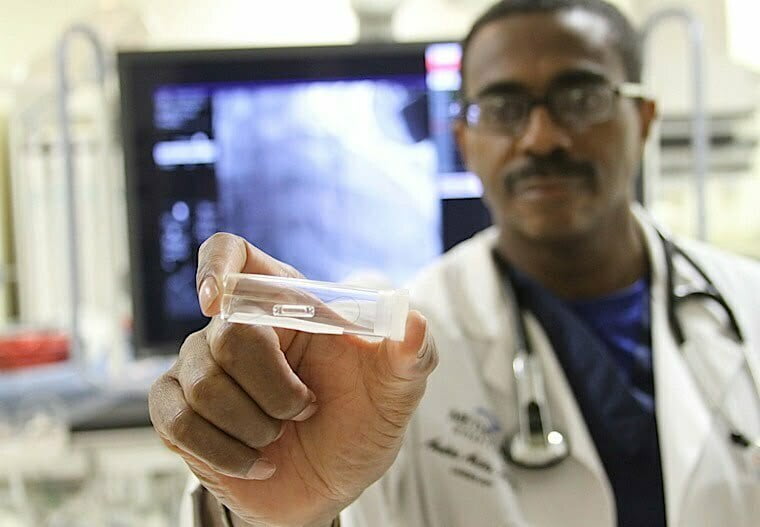Northwest Indiana has been a brawny region for generations, with an image led by steel manufacturing. In the coming years, it may become just as famous for its brains.
by Rick A. Richards
Northwest Indiana is known for a lot of things – steel mills, urban sprawl and traffic jams, but soon the list could include being a hub for technology research and development.
Few people view the region that way, but cutting edge technology is being developed at the Purdue Research Park in Crown Point, at Purdue University Calumet in Hammond and at the MIND Center on the campus of the University of Notre Dame in South Bend.
Much of what is taking place is in its infancy, but the infrastructure has been put in place to encourage research and development that ultimately could lead to new industry in the region.
Joseph Hornett, senior vice president, treasurer and chief operating officer of the Purdue Research Foundation, oversees the Purdue Research Park in Crown Point. “One of our goals is to continue supporting economic diversity in Northwest Indiana. We are doing this by recruiting high-tech companies to the Purdue Research Park of Northwest Indiana, providing competitive pricing for research and office space and providing unique partnership opportunities with Purdue.”
Currently, the Research Park of Northwest Indiana has 25 tenants specializing in life sciences, engineering, manufacturing, information technology, agri-science and energy.
While Hornett points out that steel remains the economic engine in Northwest Indiana, the effort at the research park is aimed at complementing steel. “We're working to diversify the economy in this area and enhance the economic base.
“Our economy, our nation's economy and our global economy is always changing and growing. An important aspect in staying strong economically is through technology research,” says Hornett. “We are working with officials and leaders in Northwest Indiana and throughout Indiana to help build the economy through research, technology transfer and diversifying the economy.”
While all of the projects at the Purdue Research Park of Northwest Indiana have promise, Hornett says the one with the biggest upside at this point is agri-science. “It has shown a marked increase in recent years, as has IT, life sciences, energy and engineering. Manufacturing will remain strong.”
Dr. Chenn Zhou, interim associate vice chancellor for research and graduate studies and director of the Center for Innovation through Visualization and Simulation at Purdue University Calumet, is already finding practical applications for virtual reality research going on at the campus.

“Technology plays a key role in Northwest Indiana's economy,” says Zhou. By focusing on how to integrate technology, how to apply its use and educating businesses about it, she is creating a platform for business expansion in Northwest Indiana.
“We're working directly with companies to form partnerships in virtual design,” says Zhou. Already, Purdue Calumet is working with NIPSCO on designing a virtual power plant in which to train employees and a virtual hospital to train healthcare workers.
In Gary, Zhou's lab is working on a virtual design to improve the city's transportation system and the airport.
“Absolutely industry is high tech,” says Zhou. “It's how we remain competitive. It's a great tool for training on all levels. We're doing a lot of projects with companies around the world, and it's all being done by students. And when they're done, they tend to stay in the region.”
That means Northwest Indiana is building a base of technology experts that will be attractive as new businesses look to come to the region. “I see this as the future of Northwest Indiana,” says Zhou. “This region has image issues, but we're helping with that by using our technology to help design a new lakefront for the region.”
It's in that vein that the Purdue Research Center of Northwest Indiana is nurturing small start-up companies. One is Voice to Print Captioning, a company owned by Kathy Cortopassi of Dyer.

Her background is as a court reporter, but Cortopassi wanted to expand what she did and using her ability to transcribe court documents has been working to create a technology that provides real-time closed captioning.
“As a court reporter, I felt I wasn't in charge of my own destiny. I depended on their schedule. This gives me time to be with my kids; it helps balance my life.”
Among the services Cortopassi is working to perfect is real-time weather reporting, and real-time communication for things like church services, graduation ceremonies and weddings.
“What we're doing is making life accessible to everyone,” says Cortopassi. “We took the time to learn something new, the disability culture. I learned sign language. I learned not to be afraid.
“I did this at a stage performance and afterwards a woman came up and hugged me. She said it was the best birthday present she could have. She loves going to plays but couldn't enjoy them because of a hearing loss. Now, she said her life was back.”
By providing a small device for people who need it, the captioning system is unobtrusive and simple to use. And while she loves helping others, Cortopassi also is doing the research for a highly personal reason – her first grade daughter has a hearing loss.
“I spent a lot of time dragging my feet on this,” says Cortopassi. “I realize now there are new things you need to do, and when you learn them, it makes life more exciting.”
For Legacy Environmental Services, the atmosphere at Purdue Research Park is a vibrant place to exchange ideas. “We were introduced to the research park through the Small Business Administration,” says Carl Lisek, vice president of Legacy. He and his wife, Lorrie, the company president, are partners in the business.
“We made the move to this business nine years ago. We were a clean-up business and would come in after the fact. Today, we're in the business of working with companies to prevent cleanups.

“We're eco-partners with businesses and organizations in Northwest Indiana,” says Lisek. “We help them become green and help reduce their carbon footprint.” Among the clients for Legacy Environmental are schools, governments, NIPSCO, BP and Fair Oaks Dairy.
“The capabilities of Purdue Research Park have been a win-win situation for us. By working with us and our monitoring technology, our clients received $14 million in grants. Along with its Northwest Indiana operation, Legacy also has offices in Milwaukee, Wis., and Fort Myers, Fla.
“Our goal was to make a living by being green and Purdue has given us the tools to do that. They have helped us think bigger and helped us focus on our strengths.
“Our mission is to help companies be green, sustainable and profitable at the same time,” says Lisek. Among the projects Legacy Environmental is developing is a network of electric car charging stations that could make electric cars more plentiful on region roads, thereby reducing the carbon emissions of gasoline-powered engines.
A Healthy Innovation Ecosystem
Charlie McGill, entrepreneur-in-residence for Elevate Ventures in Valparaiso, knows the importance of developing a solid base of technology research. In 1992, he founded Machine Tool Specialists, later leaving to become director of Valparaiso Economic Development and then as executive director of the Entech Innovation Center.
“It's important to have these centers of excellence, these centers of research in Northwest Indiana,” says McGill. “A lot of people believe it just happens, but that's not true. It's necessary to have a healthy entrepreneurial eco-system in place for it to happen.”
McGill says the people who come up with the ideas for new products and technology are just as important to the economy as skilled workers. “We need places for them to incubate their ideas. We need the cooperation of higher education, the media, and organizations like the Society of Innovators and investors.”
While Northwest Indiana has checked most of those items off its list, it has yet to develop a fully-funded and vibrant angel network of investors. “We're closing the gap on that, but we're not there yet,” says McGill. “It's the last piece of the puzzle and it's the most essential.”
McGill says Elevate Ventures, which has six entrepreneurs-in-residence in different regions of the state, is working with Indiana to provide advice and analysis to young entrepreneurs and help connect them with the experts who can help them thrive.
“This is really an economic gardening program,” says McGill. “Forty percent of all new jobs in Indiana will come from fast growing young firms like those being developed at technology centers in the region.”
Elevate Ventures, which manages the state's money for entrepreneurial development, has $60 million to use. Currently, its limit for any company is $1 million. “This is long overdue. The only condition we have in accepting the money is that the company brings in a CEO or director of marketing who has experience. We're teaching them that innovation is a team sport.”
The combination of research and development in real world circumstance is no more evident than at the Midwest Institute for Nanoelectronics Discovery (MIND) in South Bend. Located on the campus of the University of Notre Dame, it is a partnership with Purdue University, Penn State University, the University of Texas-Dallas, Argonne National Laboratory, the National Institute of Standards, and the National High Magnetic Field Laboratory.
Managing Director Robert M. Dunn says the work being done at MIND has put South Bend on the map. “It has raised the image of Notre Dame and Purdue and the others involved in the projects going on here.”
Dunn says MIND also is working with the city of South Bend to funnel start up business to the city's Innovation Park. Additionally, he says students from around the community, most notably from Ivy Tech, are taking advantage of the research facilities and laboratories at MIND.
Arnold Phifer is director of external relations for MIND, and he said the effort is part of the vision of the Rev. John Jenkins, president of the University of Notre Dame. “When John Jenkins became president, he was interested in making it a great research university. One way we felt we could do that was to grow in technology.”

While the primary mission of MIND is to create the next generation of microprocessors for computers, the research to get to that goal has spun off in many different directions.
One area is microfluidity in which small amounts of water are moved around on microchips to make them operate more efficiently. Phifer also says work is being done to create a portable real-time test for e-coli that can look for a single molecule of the bacteria. It has the potential to transform the food safety industry.
Researchers have also begun work in quantum tunneling, which is aimed at making semiconductors operate better by taking advantage of the behavior of electrons at the quantum level. Tunneling is described as electrons moving through – tunneling – solid material. While it seems impossible at the human level, researchers say it is normal behavior at the quantum level and would allow a current to flow through an object instead of over it.
Phifer also says one of the most remarkable discoveries could transform power generation, particularly in Third World countries. It is paint that generates electricity through small solar cells contained in the paint.
“By incorporating power-producing nanoparticles, called quantum dots, into a spreadable compound, we've made a one-coat solar paint that can be applied to any conductive surface without special equipment,” says Notre Dame researcher Prashant Kamat.
The paint can be made cheaply and in large quantities. While it isn't a major conductive source thus far, the surface of its possibilities have only begun to be discovered.


